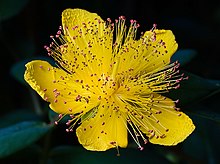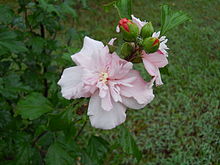Rose of Sharon

Rose of Sharon is a common name that has been applied to several different species of flowering plants that are valued in different parts of the world. It is also a biblical expression, though the identity of the plant referred to is unclear and is disputed among biblical scholars. In neither case does it refer to actual roses, although one of the species it refers to in modern usage is a member of Rosaceae. The deciduous flowering shrub known as the rose of Sharon is a member of the mallow family which is distinct from the family Rosaceae. The name's colloquial application has been used as an example of the lack of precision of common names, which can potentially cause confusion.[1] "Rose of Sharon" has become a frequently used catch phrase in poetry and lyrics.
Biblical origins[]
The name "rose of Sharon" first appears in Hebrew in the Tanakh. In the Shir Hashirim ('Song of Songs' or 'Song of Solomon') 2:1, the speaker (the beloved) says "I am the rose of Sharon, a rose of the valley". The Hebrew phrase חבצלת השרון (ḥăḇatzeleṯ hasharon) was translated by the editors of the King James version of the Bible as "rose of Sharon"; however, previous translations had rendered it simply as "the flower of the field" (Septuagint "ἐγὼ ἄνθος τοῦ πεδίου",[2] Vulgate "ego flos campi",[3]Wiclif "a flower of the field"[4]). Contrariwise, the Hebrew word ḥăḇatzeleṯ occurs two times in the scriptures: in the Song, and in Isaiah 35:1, which reads, "the desert shall bloom like the rose." The word is translated "rose" in the King James version, but is rendered variously as "lily" (Septuagint "κρίνον",[5] Vulgate "lilium",[6] Wiclif "lily"[7]), "jonquil" (Jerusalem Bible) and "crocus" (RSV).
Varying scholars have suggested that the biblical "rose of Sharon" may be one of the following plants:
- A crocus: "a kind of crocus growing as a lily among the brambles" ("Sharon", Harper's Bible Dictionary) or a crocus that grows in the coastal plain of Sharon (New Oxford Annotated Bible);
- A tulip: "a bright red tulip-like flower ... today prolific in the hills of Sharon" ("rose", Harper's Bible Dictionary);
- Tulipa agenensis, the Sharon tulip, a species of tulip suggested by a few botanists or
- Tulipa montana[8]
- A lily: Lilium candidum, more commonly known as the Madonna lily, a species of lily suggested by some botanists, though likely in reference to the lilies of the valley mentioned in the second part of Song of Solomon 2:1.[citation needed]
- Narcissus ("rose", Cyclopaedia of Biblical, Theological and Ecclesiastical Literature)[9]
According to an annotation of Song of Solomon 2:1 by the translation committee of the New Revised Standard Version, "rose of Sharon" is a mistranslation of a more general Hebrew word for crocus.[citation needed]
Etymologists have tentatively linked the biblical חבצלת to the words בצל beṣel, meaning 'bulb', and חמץ ḥāmaṣ, which is understood as meaning either 'pungent' or 'splendid' (The Analytical Hebrew and Chaldee Lexicon).
A possible interpretation for the biblical reference is Pancratium maritimum, which blooms in the late summer just above the high-tide mark. The Modern Hebrew name for this flower is חבצלת or חבצלת החוף (ḥăḇaṣṣeleṯ, or habasselet ha-khof, coastal lily). Some identify the beach lily with the "rose of Sharon" mentioned in the Song of Songs, but not all scholars accept this.[10]
Recently, some scholars have translated ḥăḇaṣṣeleṯ as "a budding bulb" in consideration of the genealogical research of multilingual versions and lexicons.[11]
Modern usage[]




The name "rose of Sharon" is also commonly applied to several plants,[12] all originating outside the Levant and not likely to have been the plant from the Bible:
- Hypericum calycinum (also called Aaron's beard due to its net-veined underside and numerous yellow stamens), an evergreen flowering shrub native to southeast Europe and southwest Asia
- Hibiscus syriacus, a deciduous flowering shrub native to east Asia, and the national flower of South Korea (also known as "Mugunghwa")[13]
- Hibiscus rosa-sinensis (var. 'Vulcan')
The term is also applied to varieties of iris, Malus domestica and Paeonia lactiflora.[citation needed]
References[]
- ^ Botanic Gardens Trust, Sydney, Australia: Why use a scientific name? Archived 2015-09-05 at the Wayback Machine
- ^ Song 2:1, Septuagint
- ^ Song 2:1, Vulgate
- ^ Song 2:1, Wiclif
- ^ Is 35:1, Septuagint
- ^ Is 35:1, Vulgate
- ^ Is 35:1, Wiclif
- ^ "Rose of Sharon". www.flowersinisrael.com. Retrieved 16 April 2020.
- ^ McClintock, John; Strong, James (1889). "Rose". Cyclopaedia of Biblical, Theological, and Ecclesiastical Literature, Vol. IX RH-ST. New York: Harper & Brothers. p. 128. Retrieved 8 October 2014.
- ^ Coastal Lily at wildflowers.co.il (in Hebrew)
- ^ Satoshi Mizota. Origin of 'Rose of Sharon' : An Analysis of Various Translations Having a Bearing on The Authorized Version Text. Dissertation for MA: Aich University, 2008."Archived copy" (PDF). Archived from the original (PDF) on 2014-02-22. Retrieved 2012-02-03.CS1 maint: archived copy as title (link)
- ^ Rose of Sharon at rhs.org.uk
- ^ Kim, Yoon (2020-04-25). "Korea's national flower".
Sources[]
- Crawford, P. L. (1995). "Rose". In Paul J. Achtemeier (gen. ed.) (ed.). Harper's Bible Dictionary. San Francisco: Harper. p. 884.
- Davidson, Benjamin (1978) [1848]. The Analytical Hebrew and Chaldee Lexicon (1st softcover ed.). Grand Rapids, Michigan: Zondervan. p. 246. ISBN 0-310-39891-6.
- Lapp, N. L. (1985). "Sharon". In Paul J. Achtemeier (gen. ed.) (ed.). Harper's Bible Dictionary. San Francisco: Harper. pp. 933–4.
- Scott, R. B. Y. (1991). "Annotations to Song of Solomon". The New Oxford Annotated Bible. New York: Oxford University Press. pp. 854 OT.
- Yu, Myŏng-jong; Lee, Ji-Hye; Chŏn, Sŏng-yŏng (2008). 100 Cultural Symbols of Korea: 100 windows showcasing Korea (First ed.). 431, King’s Garden Office Hotel 3rd Complex, 72 Naesoo-dong, Jongno-gu, Seoul, Korea: Discovery Media.CS1 maint: location (link)
- Plant common names
- Biblical phrases
- Plants in the Bible
